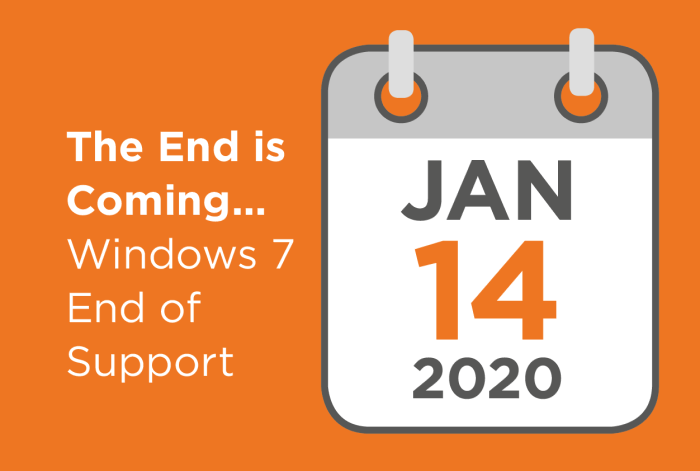The Dangers and Risks of Using End-of-Life Software
Contrary to what many may believe, computer hardware and software – including that which your company is using to support its IT infrastructure – is not designed to last forever. There comes a point in time where every piece of IT software will need to be replaced by a newer and more secure iteration, including operating systems (OS) like Windows.
Just last month, for example, Microsoft ceased to provide support for Windows 7. This means that after a decade-long run, Windows 7 will no longer receive important patches and security updates.
Other examples of OS software that has long since been unsupported include Windows XP and Windows Server 2003.

What Does ‘End-of-Life’ Mean?
When software reaches its ‘end-of-life’ stage, it will no longer be supported by the original manufacturer. This can mean different things for different types of software, however, with OS’, Windows included, it means that security updates, technical support, and software updates will no longer be provided.
‘End-of-life’ does not mean the software stops working. It will continue to work as before, however, it will become more vulnerable to security risks. As time goes by, the software becomes more vulnerable, less useful, and increasingly sluggish as it falls behind current technology and becomes plagued with vulnerabilities.
End-of-Life Software Dangers and Risks
Unfortunately, many companies fail to understand the dangers and risks of using end-of-life software (that is, software that is no longer supported by its manufacturers). This puts their infrastructure and operations at unnecessary risk. And in our digitally connected world where threats from hackers and cyber-attacks are multiplying by the day, this is an incredibly precarious situation for companies to be in.
If you are running Windows XP, Windows Server 2003, Windows Server 2008, Windows 7, or any other outdated and unsupported software package, these are just a few of the dangers and risks you are facing.
1. You become vulnerable to hacking
A lack of security updates, patches, and bug fixes is bad news. Think about it: How many pieces of software do you know of that don’t need to be patched up every now and then to fix bugs and loopholes and protect against the latest security threats? None!
Having a firewall and anti-virus software isn’t good enough; these can quickly be exploited. The best first line of defence against current attacks is a strong and up-to-date operating system.
2. You could find yourself violating regulations and standards
End-of-life software often leads to a significant risk of compliance violations, particularly if your IT systems store personal and/or financial data of your customers.
Since GDPR’s introduction in 2018, companies operating within Europe must take steps to ensure they are taking reasonable steps to safeguard data and protect it from potential security breaches. By using outdated and unsupported software, you are not taking these reasonable steps and will quickly fall outside of compliance not just with GDPR but a whole range of other regulations too, dependant on your industry.
3. You will spend more on operating costs
Outdated software at the end-of-life stage costs a lot more money to operate than the latest, supported software. The costs of maintaining and constantly fixing end-of-life software can get very steep, very fast, especially if you do not have an internal IT team capable of deploying temporary fixes. Over just a few years, these costs can very easily exceed the cost of replacing your outdated software and systems entirely.
4. Poor performance and reliability
Legacy software simply doesn’t perform as well as newer iterations of it. This adds to both cost and the risk factor because outdated, out-of-warranty software and hardware are far more prone to breaking down, and downtime costs money.
Furthermore, it is important to have robust systems that you can rely on in the current digital age. When all your business is done online, even the smallest amount of downtime caused by an outdated system can cause thousands in damage and lost revenue.
What Should I Do?
If you know that you are running an outdated operating system such as Windows 7 or Windows Server 2008, the best thing you can do is act now and upgrade.
By doing so, your business will continue to benefit from constant updates that keep your systems secure with the latest important security patches and software updates, mitigating your exposure to security risks and ensuring compliance, amongst other things.
If you are interested in learning more and think you may benefit from an automated software and patch management solution, contact ESP today to learn more.





